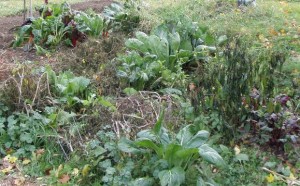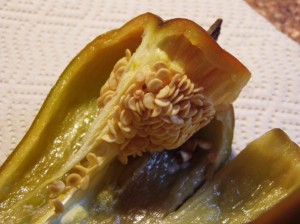 This week was, to certain extent, the ‘last hurrah’ for the garden here at Chez Siberia. We had several ‘killing frosts’ here – this is the sort of frost where basically it coats all the grass in whiteness and crunches when you walk on it. It also will literally melt everything that is not hardy to a certain extent — it explodes the water in the plant cells of plants such as tomatoes, peppers, squashes, non-hardy greens and so on.
This week was, to certain extent, the ‘last hurrah’ for the garden here at Chez Siberia. We had several ‘killing frosts’ here – this is the sort of frost where basically it coats all the grass in whiteness and crunches when you walk on it. It also will literally melt everything that is not hardy to a certain extent — it explodes the water in the plant cells of plants such as tomatoes, peppers, squashes, non-hardy greens and so on.
On the one hand, it’s a very sad time (‘gardening season is over’), but on the other hand, it’s always interesting and heartening to see what can come through a series of frosts like that with little or no damage. It gives you a real sense of just how long you can keep a garden going in the fall. When I was growing up (not at Chez Siberia – I grew up in a little town in what is coyly referred to around here as ‘the snow belt’), people were pretty firm about the gardening season, with a good amount of snow on the ground all the way into mid-April and cold through May, putting everything in on Memorial Day Weekend and things were pretty much over by late September, with a killing frost at the end of the month or the first week of October. Climate change has pretty much put pay to that, at both ends of the season. With a little forethought (as we have discussed here at KCE), we can get in seeds as early as early April and as I said, our killing frost took place this week, in the fourth week of October, so our growing season has been extended from 3.5 months to almost 6 months (yep, that whole climate change thing is a hoax, folks).
But, as you can see from the photo at the top (which shows a very messy garden which is what things look like toward the end of the season), there are things that have definitely been killed (like the pepper plants in the lower right hand side) and stuff that looks pretty darned good – like the Chinese cabbage and bock choi sorts of stuff and the rainbow chard in the upper left hand side with the red, yellow, orange, green and white stems. Something you can’t see are the beets (and their leaves, the ‘beet greens’) next to the pepper plants in the lower right hand side. Now, considering that chard and beets are from the same family, this should not surprise us at all. But it’s good to remember these two families (which we have discussed before as well) in terms of early spring and fall hardiness for gardens. They are the ‘Eveready Bunnies’ of the garden, and will just keep right on going until snowfall. Not as hardy and cold-tolerant as perhaps brussels sprouts and kale are, but out there and lookin’ good nonetheless.
Oh, so you don’t have chard and cabbage family plant seeds set aside for next spring in the fridge? mmmhmm? Well, write off to your seed supplier and get some, put them in a plastic bag in the fridge so that you are ready to get some very good early spring eating into the ground. They only need soil temperatures in the 50-degree range, which depending on where you live and how quickly the snow leaves your garden beds (or, how early you can get out with a shovel and some clear plastic to warm it up), can develop very quickly so that you can start seeds early.
Now, all things considered in this evaluation, having dead pepper plants might be a huge disappointment to some, but not to your dear old Aunty.
Pepper plants, in general, are not cold-tolerant whatsoever. I remember once we had a small lick of frost in mid-September and we lost the peppers and the tomatoes, with everything still on them. It wasn’t even all that cold – but whether it was that there was a breeze, or it was dry or whatever it was, we lost everything that we’d been waiting to harvest (‘just another couple of days until the peppers are red…just another couple of days until the tomatoes are red-der”).
So, having pepper plants which lasted through a couple of light frosts (which we did get in September) with their leaves intact and the plants upright while the tomatoes took the hit is a HUGE thing and earned these plants a spot in the ‘save those seeds’ effort for this garden (which is not called Chez Siberia for ‘nuthin’). I happened to pick a big pepper as a ‘just in case’ (because you can’t save ’em if you don’t have ’em). These are Chervena Chushka Pepper, which I got from Amishland Heirloom Seeds.
 Now, saving pepper seeds is not like saving tomato seeds – the seeds grow on a central structure inside and don’t have any sort of that same gelatinous goop (technical term, there) that you have to deal with for tomatoes. I opened it up and split the central repository in half and at the moment, everything is wrapped up in a paper towel in a dry place. Once it’s all dry, I will take off the seeds, wrap them up in another paper town and seal those up in a labeled. ziplock(tm) bag to save to start for next spring, when I will start some to evaluate, again.
Now, saving pepper seeds is not like saving tomato seeds – the seeds grow on a central structure inside and don’t have any sort of that same gelatinous goop (technical term, there) that you have to deal with for tomatoes. I opened it up and split the central repository in half and at the moment, everything is wrapped up in a paper towel in a dry place. Once it’s all dry, I will take off the seeds, wrap them up in another paper town and seal those up in a labeled. ziplock(tm) bag to save to start for next spring, when I will start some to evaluate, again.
So how did everyone else’s garden do this summer? The various Russian tomatoes we grew from heritage seeds did pretty well… until we got blight, which killed the plants outright. No blight tolerance whatsoever. Great tasting tomatoes but no tolerance for blight, which is an ongoing issue here at Chez Siberia. On the other hand, the pepper plant was planted right next to one of the blighted tomatoes and did not turn a leaf, another vote in its favor. Any standout veggies that did super-well — or super-badly — at your place?

I’m still killing off grass to turn into garden, but I did plant some yellow cherry tomatoes that vastly exceeded all expectations – I was helping a friend plant hers and she gave me the runts. And I am saving those seeds! Am in the “ferment off the goop” stage there.
Hey, Toby. I’m a little confused – isn’t Chez Siberia in a snow belt, too?
Anyway, your garden photo looks pretty good; hardly messy at all. I kinda miss those crunchy frosts…but it’s too bad about losing plants. You just never know when that killing frost will come along. Even here. When I married my ex in ’87, there were two peach trees in the backyard, in blossom. It was mid-April.When we returned from the honeymoon a week later, there had been a frost, and there were no peaches that year.
I admire your organized approach to gardening.
Cheryl — there is ‘yes, we get snow’ and then there is (cue scary music), ‘the snow belt’ which is basically anyplace that is within (plus or minus) 30 miles of Rt. 20, which goes east and west across the area where you find Buffalo, Rochester, Syracuse, Utica (but NOT Albany). These are the places which receive (in the parlance of all things weather related) ‘lake effect snow’ off the Great Lakes. This does NOT include areas at the eastern end of Lake Ontario such as Oswego and Watertown, which get their own special scary phrase, “the Tug Hill Plateau” – their snow IS lake effect; however, because they are at the eastern end of the lake, they have their own special weather conditions whereby they can get, literally, 7 feet of snow in the space of less than a week and people have to be rescued out of second floor and attic windows. I grew up in a town just south of Syracuse so we were in ‘the snow belt’. Chez Siberia gets snow but we are just far enough south of ‘the snow belt’ that our winter weather is more effected by coastal storms than by lake effect. Snow yes – snow belt, no.
When I was a kid in Pennsyltucky, we’d be listening to the radio for a snow day as the announcer droned on with how many inches the storm had dumped in various locales in PA, OH, and NY. And then we’d all ROTFL when he (always “he”) got to “…and 5’7″ in Watertown.” Fast-forward 25 years to when my California-bred first husband wondered why the Army was sending him to, yep, Watertown for Arctic training. “You’ll see,” said I.